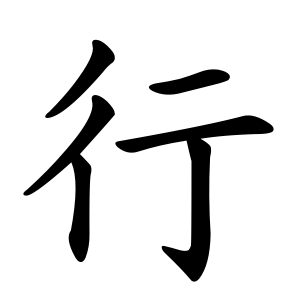行
- to go, to walk, to perform;
- rank;
- lineage (항렬);
It is used to express actions like moving or proceeding and can also refer to a generation or order within a family lineage.
Etymology
It is a pictogram representing a crossroads where four paths meet. Since it depicts a path that people travel, it carries the meaning of “to go” or “to walk,” from which the extended meanings “to move” and “to act” are derived. Therefore, characters that include 行 as a component generally imply movement.
In Chinese, the 行 radical has been merged into the 彳 radical.
Usage in Korean
Originally, the meaning “to go” was read as 행 (haeng), while meanings such as “row” or “store/shop” were read as 항 (hang). For example, words like 행렬 (matrix/row), 은행 (bank), and 양행 (foreign trade) were originally 항렬, 은항, 양항. However, except for terms like 안항 and 항렬, 항 mostly changed to 행, and 행렬 and 항렬 came to be used with different meanings.
It is placed between the ‘body’ components 彳 and 亍 to form Chinese characters. Specifically, various shapes are inserted between 彳 and 亍 to create characters.
Examples include:
街 (street)
衢 (crossroads)
術 (skill/art)
衍 (expand)
衛 (protect)
衝 (pierce)
Characters with 行
Words that derived from 行
- 강행(強行)–pushing ahead; enforcement
- 강행하다(強行하다)–push ahead; enforce
- 보행(步行)–walking
- 비행기(飛行機)–plane; airplane
- 비행선(飛行船)–airship; dirigible; lighter-than-air craft
- 비행장(飛行場)–airport; airfield
- 실행(實行)–practice; execution
- 실행되다(實行되다)–be practiced; be executed
- 악행(惡行)–evil conduct; wrongdoing
- 언행(言行)–words and actions
- 완행(緩行)–going slow; slow bus; slow train; local train
- 완행버스(緩行bus)–slow bus
- 운행(運行)–running; operation; service; movement; revolution
- 직행(直行)–nonstop; express
- 직행버스(直行bus)–express bus; nonstop bus
- 진행(進行)–progress
- 초행(初行)–first trip; first visit; new road
- 초행길(初行길)–new road
- 행(行)–line
- 행동(行動)–action; movement behavior; deed
- 행방(行方)–whereabouts
- 행성(行星)–planet
- 행위(行爲)–act; action; conduct; deed
- 행적(行跡/行績/行蹟)–trace; mark; trail; achievement; accomplishment; deeds; track record; performance
- 흥행(興行)–show; performance; box office hit; box office success
- 竹人一一弓 (HOMMN)
- ⿰ 彳 亍
